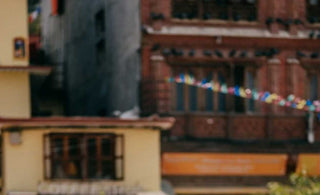
Introduction:
Nestled in the heart of the Himalayas, where spirituality seamlessly intertwines with culture, Nepal stands as a symbol of ancient traditions. Among the vibrant expressions of faith, the Nepalese prayer flags, known as Lung ta, capture the essence of spiritual devotion and collective blessings. What sets these prayer flags apart is the diagonal arrangement, creating a visually striking display that reflects the interconnectedness of life. In this exploration, we delve into six aspects of the Lung ta style, unraveling its cultural significance, delving into the symbolism embedded in each flag, exploring the artistry in their creation, examining the rituals surrounding their hanging, assessing their impact on communities, and contemplating the enduring spiritual legacy they leave behind.
1. Cultural Significance:
The hanging of Lung ta prayer flags holds profound cultural importance in Nepal. The term "Lung ta," translated as "wind horse," signifies that the power of the wind can carry prayers and blessings across the land. The diagonal hanging of these flags reflects the dynamic flow of energy and the interconnectedness of all things. This style captures the spiritual essence of diverse communities in Nepal, uniting them in a common commitment to harmony, happiness, and prosperity.
2. Symbolism Woven into Each Flag:
Lung ta prayer flags are more than just colorful pieces of cloth; they are repositories of deep-rooted symbolism from Buddhism and Tibetan traditions. Each color carries its own significance—blue for the sky, white for air, red for fire, green for water, and yellow for the earth. The prayers, mantras, and symbols imprinted on the flags imbue them with spiritual power. When hung diagonally, these symbols interweave, creating a meaningful tapestry resonating with the elements of nature and spiritual dimensions.
The decision to hang Lung ta prayer flags diagonally is not arbitrary; it is a deliberate choreography of symbolism. As the flags sway on a diagonal axis, they engage in a dance of sacred symbols, creating a visual symphony that resonates with onlookers. The diagonal arrangement serves as a metaphorical bridge between the earthly and celestial realms, embodying the dynamic flow of spiritual energy that courses through the landscape.
3. Artistry in Creation:
The creation of Lung ta prayer flags is an art form that marries craftsmanship with spirituality. Whether through woodblock printing or meticulous hand-painting, each flag is a testament to the skill and intention of the artisan. The diagonal hanging style accentuates the aesthetic appeal, transforming the act of hanging flags into a sacred art form. The flags, when suspended diagonally, become not just pieces of cloth but living canvases that tell stories of devotion and creativity.
Crafting Lung ta prayer flags is an art, reflecting the skill and dedication of the artisans. Traditionally produced through woodblock printing or hand-painting, each flag is a unique piece of craftsmanship. This meticulous process involves selecting auspicious symbols, infusing them with prayers, and adorning them with vibrant colors. Attention to detail is not merely aesthetic; it is a spiritual practice, ensuring that each flag becomes a conduit for positive energy and sacred blessings.
4. Rituals Surrounding Hanging:
Hanging Lung ta prayer flags is not a casual affair; it is a deeply ingrained sacred ritual in Nepalese culture. Communities gather, often during auspicious occasions or festivals, to raise these flags. The process involves intentional setting of intentions, recitation of prayers, and a collective effort to let the flags flutter in the wind. The diagonal direction symbolizes a harmonious dance between the material and spiritual realms, inviting blessings to permeate every corner of the community.
The act of hanging Lung ta prayer flags is not a casual affair; it is a sacred choreography that unfolds during auspicious occasions or significant festivals. The process involves more than physical placement; it is a spiritual communion where aspirations are set, and prayers are collectively recited. The choice to hang the flags diagonally is a deliberate gesture, symbolizing the alignment of earthly aspirations with the celestial forces. It is a moment of collective intention, where the flags become emissaries of the community's shared hopes and blessings.
5. Impact on Communities:
The hanging style of Lung ta prayer flags transcends mere symbolic significance; it has a profound impact on the communities practicing it. As the flags flutter in the wind, they become conduits for collective wishes. The shared intent for peace, prosperity, and spiritual awakening unites individuals, fostering resonance in community and interpersonal relationships. The Lung ta style, as a visual reminder, prompts the community to commit to coexistence and influences daily interactions and relationships among its members.
6. Enduring Spiritual Legacy:
Beyond the immediacy of rituals and collective gatherings, the Lung ta prayer flags create a lasting spiritual legacy. The flags continue to flutter in the wind, carrying the prayers and blessings of generations. The diagonal arrangement, with its dynamic movement, symbolizes the eternal cycle of life, death, and rebirth. Thus, the Lung ta style becomes a timeless expression of the impermanence of existence, becoming part of the cultural heritage and leaving a profound spiritual imprint.
In conclusion, the tradition of Lung ta prayer flags, with its deeply embedded cultural significance and the unique choice of diagonal hanging, paints a vibrant portrait of Nepal's spiritual and artistic richness. The fluttering flags, resonating with the breath of the wind horse, stand as a testament to the enduring symbiosis between spirituality and daily life in this Himalayan nation.























